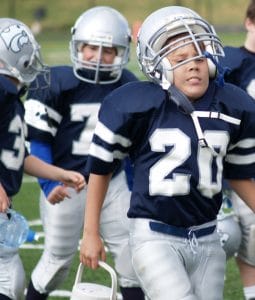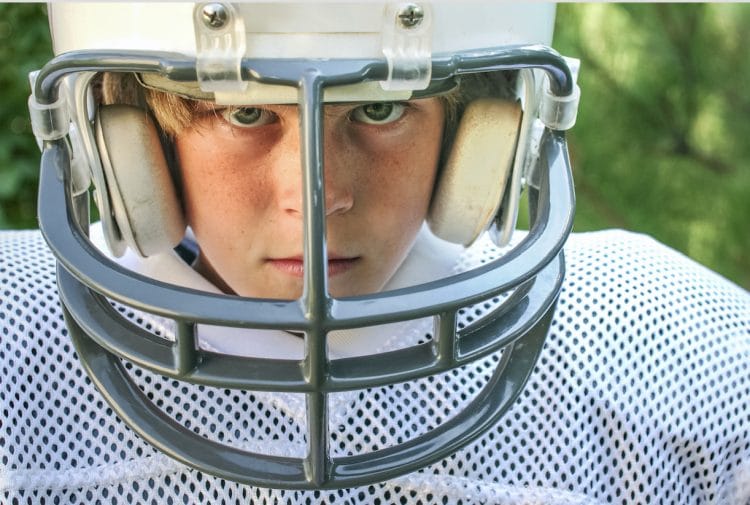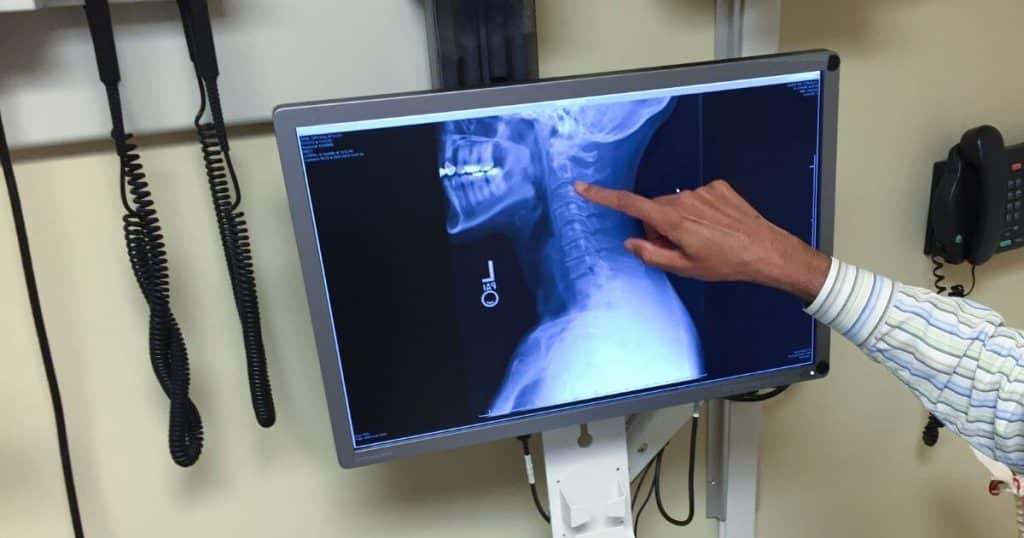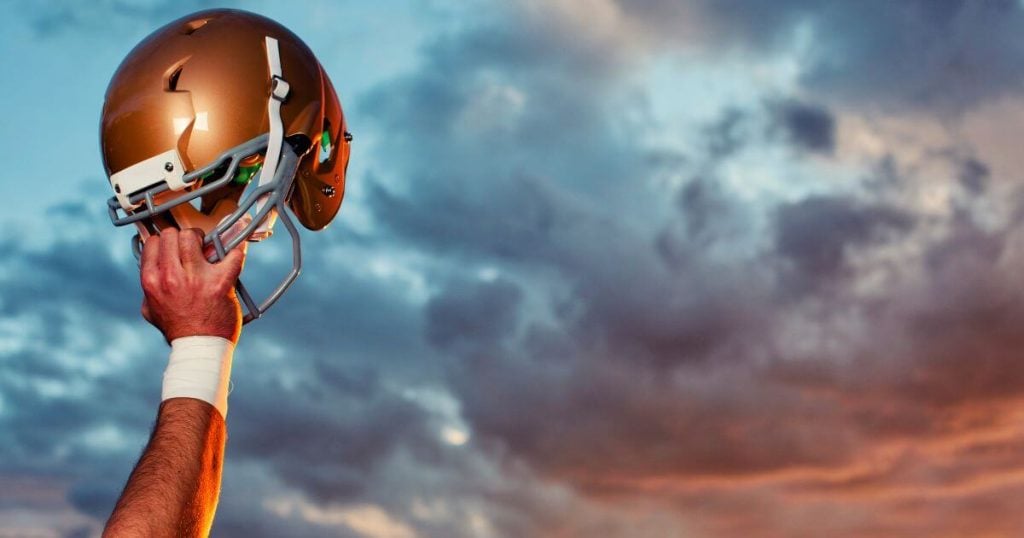My eight year old son, Oscar, recently decided he just HAD to join an American Football team.
So we contacted our local football league. I took him round the fieldhouse to give the deposit cheque and get him kitted out.
Concerns About Helmet Weight
When they gave me his helmet, I was gobsmacked by how heavy it was and immediately said, “Wow! Do you see a lot of neck injuries from these things?”
Oh no, they assured me, the kids soon get used to them and the neck muscles strengthen.
A Parent’s Perspective
As the day wore on, my uneasiness increased, so I did a wee bit of research on the subject and guess what?
My good old gut reaction had steered me right, yet again. So here’s the email I sent to the coach:
**************************************
Unfortunately, having now seen and felt the weight of the helmet, plus doing a good bit of research on the Internet. I strongly believe wearing a helmet of that weight is not safe for Oscar.
I’m not just concerned about overt damage to the cervical spine, which one can argue is infrequent. I’m more concerned with “undetectable” soft tissue, fascia and visceral damage.
I am sure if we were to take that helmet to an osteopathic doctor they would have a lot to say about why a helmet of that proportionate weight is not a good idea for a developing child whose plates in their skull have not even closed (they do not close fully until age 20).
Research and Findings
A pediatric head and neck injury review showed that in children under age 12, while the head is 90-95% of adult size, the neck is only 75-85% of adult size.*
This further compounds the strain on the neck and shows that for children, their necks are under more proportionate strain and pressure than adults. In addition, the report showed that their neck muscles are weaker to begin with.*
The Weight and Kids’ Neck Health
Oscar’s height is 4’2″ and his weight is 65 lbs. I believe the helmet (with face guard) he got weighs close to 7 or 8 lbs. You’d have to check that though as the scale I have is not reliable. Don’t know how that compares proportionately to adult body weight vs. helmet weight. Would be interesting to check though!
Since the helmet is 10% (or more) of Oscar’s body weight, then the weight of a helmet on a 200 lb football player would have to be 20 lbs for that adult to be carrying a proportionate weight load – keeping in mind that his neck is 25% bigger and MUCH stronger, as well.
I tried to find weights of adult helmets on the Internet, but the only one I could find was an ebay listing for what looked like a fairly old adult helmet and its weight was stated as 5 lbs.
The Reflex Factor
Combined with the fact that the body’s reflex when being charged, hit, etc is to lower the head, I don’t think teaching kids to keep their head up (to minimize risk of cervical spine damage) is going to be foolproof in the heat of the moment.
In my experience (as a martial artist) it takes a considerable amount of time and practice to overcome an innate reflex.
I have spoken to Oscar about this and since I teach all my kids to – above all else – listen to their own body.
Listen To Your Body
I had him hold the helmet, do some deep breathing and ask his own body whether he felt the helmet was good for his body, or not.
He responded that when he held the helmet on his lap, his body said it was okay. But when he put it on his head, his body said it was not good.
Hence, he too has decided that playing for the Titans is not a good idea for him.
**************************************
| NEXT: Getting Kids To Listen
Why You Should Pay Attention?
If your child, teenager, etc. plays football or is considering it, this is definitely an issue you want to look at!

By age 4, the size of a child’s head (as indicated by head breadth, depth and circumference) is 90% that of an adult and by age 12 it is 95% of adult size. It is not until age 20 that the bone plates of the skull fully close.
Understanding the Anatomy
An important consideration in helmet standard development that Mr. Edward Becker pointed out is that the facial structure of children is vastly different from that of adults. Children’s heads are smaller in vertical height than adults’.
The brain and skull of a child have different biomechanical properties than adults’. The greater water content in a child’s brain makes it stiffer than that of an adult, noted Dr. Margulies.
In addition, her research has found that skull stiffness increases with age. Based on her studies in pigs and young children, she concluded that the infant’s less stiff skull properties are likely to increase the magnitude of intracranial strains that occur during head injuries involving impact.
But she noted that whether that is also true for older children is not known.
Conclusion and Safety Considerations
The neck, in contrast to the head, is only 75% of adult size at age 4 and 85% of adult size by age 12, according to UMTRI data. The head-volume to neck-area ratio at age 12 is still greater than what is seen for adults.
In addition, Dr. Kristy Arbogast noted that the neck muscles of children are weaker than adults, and children’s neck ligaments can stretch more. She also pointed out that children bend their necks at higher vertebral levels than adults. Their vertebral joints are flatter so they don’t restrict forward motion as much as in adults.”
SOURCE: Review of Pediatric Head and Neck Injury: Implications for Helmet Standards
Editors: Kristy B. Arbogast, Susan S. Margulies, Margie Patlak, Hal Fenner, Daniel J. Thomas




WOW you are an overprotective parent. he wants to play football? he has a risk of breaking his neck in every game and your worried about his helmet weighing to much?
23. I do not even know how I ended up here, but I thought this post was good. I don’t know who you are but definitely you’re going to a famous blogger if you aren’t already 😉 Cheers!
I played football from early childhood through college. I started out really scrawny and weak. I remember first getting my helmet. My neck was sore for the first week. Eventually, the soreness went away as my neck got stronger (although not noticeable bigger). Over time however, my neck got really big. The thing is, we never did any “weightlifting” for our neck muscles. Just wearing that helmet made my neck grow in size over years. The key to it, is the kids must be taught the proper technique, and they don’t need to be on the field with other kids way above their size or skill levels. Their are two important aspects to neck safety. The first is not trying to hit (tackle) someone with the top of your helmet. We are taught to put our face mask into one of the numbers on their jersey. The second is stretching the neck muscles daily. Our pre-practice stretch routine included this, even when we were just in shorts (we still wore our helmets), and not having any contact drills that day – we still stretched our neck muscles. They must stay elongated and flexible so that the cervical discs do not compress gradually over time. I’d worry more about concussion related issues. If I have a son one day, I will not encourage him to play football due to the repeated head trauma.
GREAT feedback from someone who’s been there Joseph! Thanks so much sharing your experiential knowledge. And sorry I didn’t see your comment until now – weird!